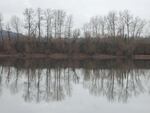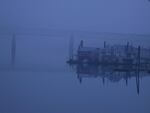
The Willamette River as it flows north towards the Columbia.
SALEM, Ore. -- The Willamette doesn’t feel like a wild river from the boat ramp under the Highway 22 bridge. The noise of traffic lingers even as I paddle my canoe downriver, through a corridor of green trees, to meet Tim Palmer.
Palmer's been canoeing and camping on the Willamette for the last seven days and he talks about this river as if it were some wooly wilderness.
"So I had this idyllic beautiful quiet, night, all I heard were beavers slapping along the water, they sound like this ... so I had that about every two hours in the night, might wake me up…that’s kinda nice," Palmer said.
Palmer is an environmental writer, and this 14-day canoe journey is actually research for an upcoming book about the natural history of Oregon rivers.
Now you might wonder why he picked the Willamette of all rivers to spend two weeks on. But the trip, which began on the McKenzie and will end at the confluence with the Columbia, will be remarkably dam-free, at least until he reaches the Willamette Falls dam in Oregon City.
"There are only, say, three mega-trips in Oregon that you can do in a canoe in Oregon without major dams to cope with, and the Willamette is the longest. This trip will be about 230 miles," Palmer said.
The Willamette, with its reputation for runoff and sewage overflows, isn’t at the top of most "must-paddle" lists. But Palmer thinks the river should get credit for what it does have. He points to a grove of old and young cottonwoods along the shore that wouldn’t be here if the entire river was plugged with dams.
"Many creatures depend on them. Cottonwoods totally depend on free flowing rivers because while there are millions of seeds that blow and germinate and settle, they need either a freshly scoured flood plain or a fresh silt bed from a big flood to germinate. So where we have rivers that are highly regulated, cutting out those floods flows upstream, you don't have that silt deposit. The cottonwood forests gradually die out," he said.
We take a break on a gravel bar covered with green trees and singing birds. Palmer says the Willamette is actually full of natural places like this.
"That was a killdeer. That’s a shorebird you often see on gravel bars like this," he said.
As we walk Palmer points to a shrubby, wiry plant that thrives here even with periodic flooding in this section of river.
"Yeah, so here we have Pacific Willow this is the most common willow we have along our streams, vitally important to the health of the river. This is the favorite food of beavers," Palmer said.
The Willamette has its problems. From pollution to dwindling salmon runs. But Palmer points out it's a rare major river today that is unobstructed for as long as this one.
There are 1,720 dams in Oregon that are 10 feet tall of have 15 acre feet of capacity or more.
"That's a lot of dams in our state. There are 80,000 nationwide. They’ve been built almost everywhere it made sense to do it," he said.
Across the Northwest, more and more dams are coming down. Palmer says that means Oregonians in the future will have more opportunities to experience rivers that are wild and free-flowing, like this section of the Willamette.
As Palmer explained, the Willamette is a "kind of a river for the people, ya know it’s a river for almost anybody with even a little experience to get out and do -- mile after mile after mile, on and on. To me it's the real tour of Oregon."
(This was first reported for opbnews.org.)


